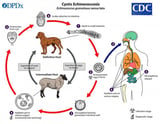Life Cycle of a Beef Tapeworm
Tapeworms (cestodes) are apartment, parasitic worms. The four master abdominal cestode pathogens of humans are
Other cestode species also infect humans, causing diseases such as sparganosis Sparganosis Sparganosis is infection with larvae of Spirometra species or Sparganum proliferum tapeworms. Adult Spirometra species and Sparganum proliferum tapeworms infect dogs... read more , coenurosis Coenurosis (Taenia multiceps, Taenia serialis, or Taenia brauni Infection) The tapeworms Taenia multiceps, Taenia serialis, Taenia brauni, and Taenia glomeratus are rare causes of homo infection, which is acquired by adventitious ingestion... read more , and echinococcosis Echinococcosis Echinococcosis is infection with larvae of the tapeworm Echinococcus granulosus (cystic echinococcosis, hydatid disease) or Echinococcus multilocularis (alveolar affliction). Symptoms... read more than  . Cestode infection is typically foodborne or acquired by accidental ingestion of invertebrate hosts.
. Cestode infection is typically foodborne or acquired by accidental ingestion of invertebrate hosts.
All cestodes wheel through three stages—eggs, larvae, and adults. Adults inhabit the intestines of definitive, or concluding, hosts, which are mammalian carnivores, including humans. Several of the adult tapeworms that infect humans are named after their main intermediate host (the fish, beef, and pork tapeworms). An exception is the Asian tapeworm Taenia asiatica (Asian Tapeworm) Infection Infection with the Asian tapeworm, Taenia asiatica, is limited to Asia. It is very similar to infection with T. saginata, but the primary beast reservoir is pigs rather than cattle... read more (Taenia asiatica), which is like to T. saginata in many respects, but it is acquired by eating pork in Asia.
Cestode infection spreads when eggs laid past adult tapeworms in the intestines of definitive hosts are excreted with feces into the environment and ingested by an intermediate host (typically some other species). Eggs hatch into larvae, which develop, enter the circulation of the intermediate host, and encyst in the musculature or other organs. When the intermediate host is eaten raw or undercooked by the definitive host, the parasites are released from the ingested cysts in the intestines and develop into adult tapeworms, restarting the bike. With some cestode species (eg, T. solium), the definitive host can also serve as an intermediate host; that is, if eggs rather than tissue cysts are ingested, the eggs develop into larvae, which enter the apportionment and encyst in various tissues.
Adult tapeworms are multisegmented flat worms that lack a digestive tract and absorb nutrients directly from the host'south pocket-sized bowel. In the host'due south digestive tract, developed tapeworms tin go big; the longest parasite in the world is the 40-m whale tapeworm, Tetragonoporus calyptocephalus.
Tapeworms have 3 recognizable portions:
-
The scolex (head) functions as an anchoring organ that attaches to intestinal mucosa.
-
The neck is an unsegmented region with high regenerative capacity. If treatment does not eliminate the cervix and scolex, the entire worm may regenerate.
-
The rest of the worm consists of numerous proglottids (segments). Proglottids closest to the neck are undifferentiated. As proglottids motion caudally, each develops hermaphroditic sex organs. Distal proglottids are gravid and contain eggs in a uterus. Mature proglottids incorporate a single ovary—eggs are noted because they are visible on microscopy.
Representative structure of a tapeworm, based on Taenia solium
Size and morphology vary depending on species and maturity.
Symptoms and Signs of Tapeworm Infections
In contrast to adult tapeworms, larvae can crusade severe and even lethal disease when they develop in extraintestinal sites, most importantly in the encephalon, simply also in the liver, lungs, eyes, muscles, and subcutaneous tissues. In humans, T. solium causes cysticercosis and Echinococcus granulosus and Echinococcus multilocularis crusade cystic hydatid affliction and alveolar affliction, respectively. T. saginata does not cause cysticercosis in humans. It is not clear if T. asiatica causes cysticercosis in humans or not. Rarely, larvae of Spirometra species, Sparganum proliferum, Taenia multiceps, Taenia serialis, Taenia brauni, and Taenia glomeratus can as well infect humans, producing mass lesions in subcutaneous tissue or musculus, and less commonly, encephalon or eye depending on the infecting species.
-
For developed tapeworm infections, microscopic examination of stool
-
For larval disease, imaging
Adult tapeworm infections are diagnosed by identifying eggs or gravid proglottid segments in stool. Larval disease is best identified by imaging (eg, brain CT and/or MRI). Serologic tests may also be helpful.
-
Anthelmintic drugs
The anthelmintic drug praziquantel is constructive for intestinal tapeworm infections. Niclosamide is an alternative that is non available in the United states. Nitazoxanide can exist used for H. nana infections.
Some extraintestinal infections respond to anthelmintic treatment with albendazole and/or praziquantel; others require surgical intervention.
Prevention and control involve the post-obit:
-
Thorough cooking of pork, beef, lamb, game meat, and fish (recommended temperatures and times vary)
-
Prolonged freezing of meat for some tapeworms (eg, fish tapeworm)
-
Regular deworming of dogs and cats
-
Prevention of recycling through hosts (eg, dogs eating dead game or livestock)
-
Reduction and avoidance of intermediate hosts such as rodents, fleas, and grain beetles
-
Meat inspection
-
Germ-free handling of human waste
Smoking and drying meat are ineffective in preventing infection.

shared.CopyrightLabel © 2022 Merck & Co., Inc., Rahway, NJ, The states and its affiliates. All rights reserved.
Source: https://www.msdmanuals.com/professional/infectious-diseases/cestodes-tapeworms/overview-of-tapeworm-infections